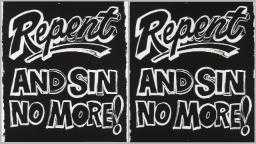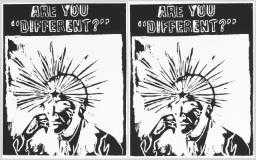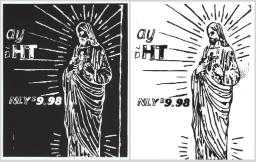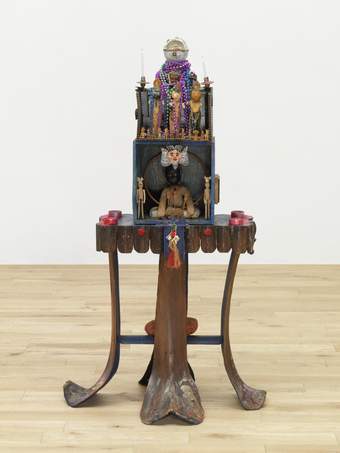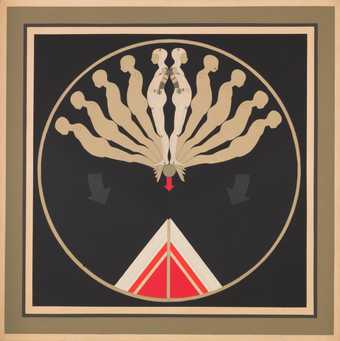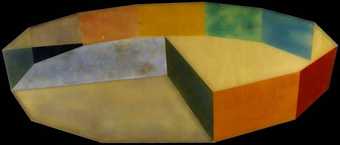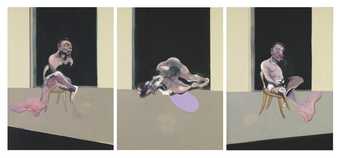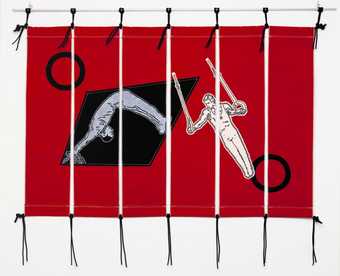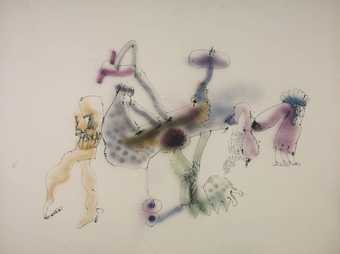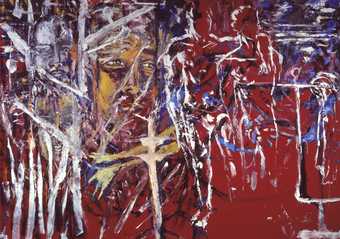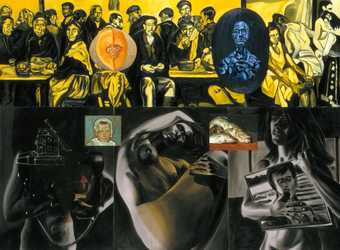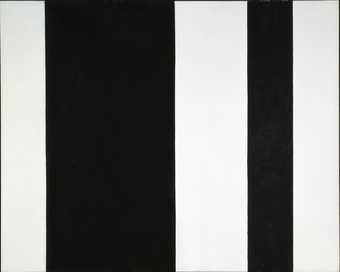
Not on display
- Artist
- Jedd Garet born 1955
- Medium
- Acrylic paint on 2 canvases
- Dimensions
- Support: 3465 × 1860 × 43 mm
- Collection
- Tate
- Acquisition
- Presented by Mr Frederic Mueller through the American Federation of Arts 1985
- Reference
- T04127
Display caption
In the 1980s, Garet painted a series of works featuring generalised and idealised figures. He described these human forms as ‘statues, not people'. Here, this sense of artifice is heightened by the shafts of light passing behind the figure suggesting stage lighting. Garet used two canvases for his paintings to allow him to work on a larger scale. This technique allowed him to misalign the two sections, skewing the image, as if viewed through a prism. Garet described the title of this work as merely 'a phrase I liked'.
Gallery label, August 2021
Does this text contain inaccurate information or language that you feel we should improve or change? We would like to hear from you.
Catalogue entry
Jedd Garet born 1955
T04127 To Rule the World
1985
Acrylic on two canvases, from top to bottom 1860 x 1860 (73 1/4 x 73 1/4), 1605 x 1830 (63 1/4 x 72); overall size 3465 x 1860 (136 1/2 x 145 1/4); painted edges 42 (1 5/8) deep
Inscribed on back of top canvas ‘Jedd Garet | 1985' centre left, ‘To Rule the World | TOP' t.l., and on back of bottom canvas ‘Garet 85' centre left, ‘To Rule the World | (bottom)' near top left
Gift of Mr Fredric Mueller through The American Federation of Arts 1985
Prov: Acquired from the artist by Fredric Mueller, New York 1985
Exh: Biennial Exhibition, Whitney Museum of American Art, New York, March-June 1985, (no number, repr. p.36)
In a letter to the compiler postmarked 21 March 1988, the artist has stated that ‘To Rule the World' is ‘perhaps the last' of the series of paintings begun in 1979 which feature sinuous male figures.
Garet's early works of this type show clear reference to the mannequins and fragments of classical statuary and architecture found in the paintings of Giorgio de Chirico. In this he was responding to a contemporary revival of interest in the aesthetic and critical status of the late works of the Italian painter who had exercised seminal influence on Metaphysical painting and Surrealist art in the interwar period. At the same time, the play of curves found in Garet's simplified images of figures allude also to the biomorphist imagery of artists such as Hans Arp and Yves Tanguy, key figures in the Surrealist movement. Garet's overt references to recent art history have led his work to be dubbed both ‘neo-surrealist' and ‘mannerist'.
The dependency of Garet's imagery upon the work of other artists underlines its anti-naturalism. The artist has been quoted as saying that he wanted in his figure paintings ‘no natural elements, nothing natural, including the figures. They were statues, not people', (Robert Pincus-Witten, Jedd Garet, Pasadena 1984, p.31). The irreality of Garet's imagery is reinforced by the suggestions of stage settings found in many of his works. ‘Yellow Fever', 1980, (Morton Neuman Family Collection, Chicago, repr. ibid., [p.55] in col.), for example, which shows lying on a block a sinuous figure, arms wrapped around the head and legs enlaced, is framed at the top and side of the painting by what appear to be draped curtains. In this context, the shafts of light that pass behind the body of the figure in T04127 appear to have both sexual and theatrical overtones. Robert Pincus-Witten relates Garet's imagery of beams of light in shallow stage-like settings to the ‘factitious studio prop classicism of '40s and '50s movies and advertising as well as the lurid stage lighting we associate with these manifestations. He continues, ‘By the early '70s all this had become paradigmatic to the gay coding of the contemporary homo-erotic stance' (ibid., p.23).
Garet avows that his style of painting has homosexual connotations but argues that his subject matter is not sexually specific. He is quoted as saying that the figures in his paintings are not ‘sex phantoms': ‘They are idealized and generalized. They are rendered without genitals. They are streamlined'. In not painting hands and feet he says that he aims to suggest not ‘frailty and vulnerability' but ‘refined idealisation' (ibid. pp.26-7).
The whirlpool motif in the lower canvas of T04127 appears to have its source in the pronounced brushwork and swirl patterns found in the background of many of Garet's early figure works which may have reflected contemporary interest in America in new German Expressionist painting. A close antecedent for the image of the lower canvas is found in ‘Whirlpool of Pleasure', 1981 (private collection, repr. ibid., [p.89] in col.).
In conversation with the compiler on 4 May 1988 the artist said that he began to use two canvases in his paintings in 1984, simply in order to work on a larger scale. In T04127 the two parts of the body appear misaligned. This skewing of the image, the artist said, was designed to suggest the effect of seeing the image through a prism. Commenting on his choice of title the artist described it as ‘a phrase I liked'.
This entry has been approved by the artist.
Published in:
The Tate Gallery 1984-86: Illustrated Catalogue of Acquisitions Including Supplement to Catalogue of Acquisitions 1982-84, Tate Gallery, London 1988, pp.152-3
Explore
- abstraction(8,615)
-
- from recognisable sources(3,634)
-
- figure(2,270)
- heating and lighting(846)
-
- light, spotlight(21)
- mannequin(52)
- actions: postures and motions(9,111)
-
- twisting(60)
- figure(6,809)
- sex and relationships(833)
-
- homosexuality(1,673)
You might like
-
Andy Warhol Hamburger
1985–6 -
Andy Warhol Repent and Sin No More!
1985–6 -
Andy Warhol Are You Different?
c.1985–6 -
Andy Warhol Christ $9.98 (negative and positive)
1985–6 -
Andy Warhol Camouflage
1986 -
Betye Saar Mti
1973 -
Ernest Trova Falling Man 80
1963 -
Ron Davis Vector
1968 -
Francis Bacon Triptych August 1972
1972 -
John Dugger Sports Banner
1980 -
John Altoon Black and White 55
1963 -
Julian Schnabel Homo Painting
1981 -
David Salle Satori Three Inches within Your Heart
1988 -
John Baldessari Hope (Blue) Supported by a Bed of Oranges (Life): Amid a Context of Allusions
1991 -
John McLaughlin #6-1973
1973


